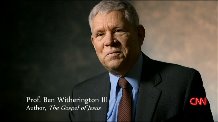One of the more controversial aspects of the Gospels is the two genealogies we have for Jesus, one in Mt. 1.1-17 the other in Lk. 3.23-38. While there are a few similarities between the two (e.g. they both mention that Jesus is the ‘so-called’ son of Joseph), they are mostly different, and they serve very different purposes. Some Bible students along the way have tried to suggest that we have Mary’s genealogy in Luke, and Joseph’s in Matthew, but this solution simply doesn’t work, since Joseph and his ancestry is referred to in both cases. Matthew clearly says that Jacob begat Joseph, but Luke has the more elliptical phrase ‘Joseph of Heli’, which could possibly mean ‘son of’ or ‘grandson of’ but it depends on what we think this same sort of Greek phrase means in the others case, probably ‘son of’. Could Heli and Jacob be the same person? Or could one genealogy be dealing with Joseph’s paternal grandparent and the other with his father? One cannot be sure. But here are a few things to keep in mind when evaluating these two genealogies.
Firstly, Luke’s, is an ascending genealogy (tracing Jesus all the way back to Adam, and thence to God) and focuses on Jesus’ human ancestry in general. The other, Matthew’s, is a descending genealogy and is a strictly Jewish genealogy that wants to establish that Jesus is a descendent of Abraham and of Moses and of David, and thus is the Jewish messiah. Neither genealogy attempts to be complete, but rather they are selective and stylized. In royal genealogies in antiquity often the skeletons would be left in the closet, and sometimes whole generations would be left out of account. The genealogy was intended to be illustrative of the ancestry, not an exhaustive account thereof. Furthermore, in the case of Matthew’s genealogy, there is an attempt to suggest that Jesus is the perfect descendent of Abraham, noticing the references to three sets of 14 generations, with seven being the number of perfection.
Because Matthew is trying to shoe horn Mary and Jesus into Joseph’s genealogy (a reasonable thing to do since if Joseph adopted or accepted Mary’s child, by Jewish tradition he was entitled to Joseph’s genealogy in the bargain), because of the virginal conception,many scholars have suggested that the odd references to various notable or notorious women in this otherwise all male genealogy is meant to prepare for the irregularity of mentioning Mary, the mother of Jesus (and his only physical parent) who came by her child in an irregular way. So we have Tamar, Rahab, Ruth, and Uriah’s wife (i.e. Bathsheba), and what all these women share in common with Mary is ‘irregular unions’. In other words, God can use all kinds of irregularities his wonders to perform, even to produce his messiah, the final anointed king.
Finally, Matthew and Luke (though not directly in his genealogy in Luke 3), both feel compelled to mention the virginal conception. It seem quite clear that Luke did not get his genealogy from Matthew (though see his reference to sources consulted in Lk. 1.1-4), nor did Matthew get his from Luke, and yet they both feel compelled to mention a virginal conception, which early Jews were not expecting when the Messiah came into this world. They did not interpret Isaiah 7.14 that way, though Isaiah’s text is general enough that it could be interpreted in such a fashion. What Isaiah 7.14 was normally taken to mean was a nubile young woman of marriagable age (who would be presumed to be a virgin in that honor and shame culture) will conceive (it was assumed by a normal means) and give birth to a royal child, who will be given throne names like Immanuel, ‘God with us’. In other words, the Hebrew text was not viewed as focusing on a miraculous virginal conception, but it was open to such an explanation.
What we need to understand then is that it was the irregular and miraculous event in the life of Mary which caused the re-reading of Is. 7.14 in a way that suggested a virginal conception was meant. It was not the text of Is. 7.14 that generated the idea that Jesus was conceived of a virgin. It is highly unlikely that either the First or Third Evangelist would make up the idea that Jesus was virginally conceived because: 1) early Jews didn’t expect such a thing of their coming messiah, and 2) to the skeptical this would sound like a cover up for something scandalous, namely that Mary got pregnant out of wedlock in the way that women often got pregnant out of wedlock. Indeed, there was a later rabbinic tradition that Mary was impregnated by a Roman soldier named Pantera or Panthera. In other words, Luke and Matthew record the virginal conception because they feel compelled to do so, because they are convinced that is how Jesus actually came into this world, and Matthew is scrambling back to the OT, to Is. 7.14 to be able to show that this irregularity was part of God’s plan of salvation all along, a plan that had many such irregularities along the way.













